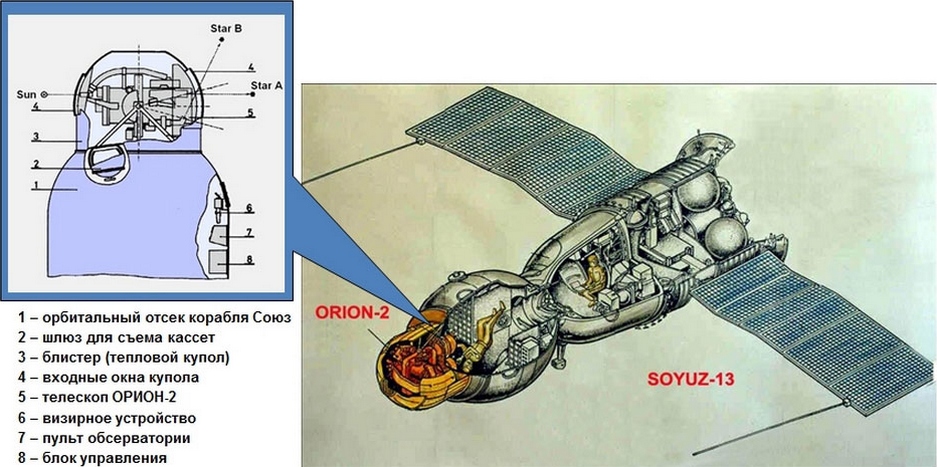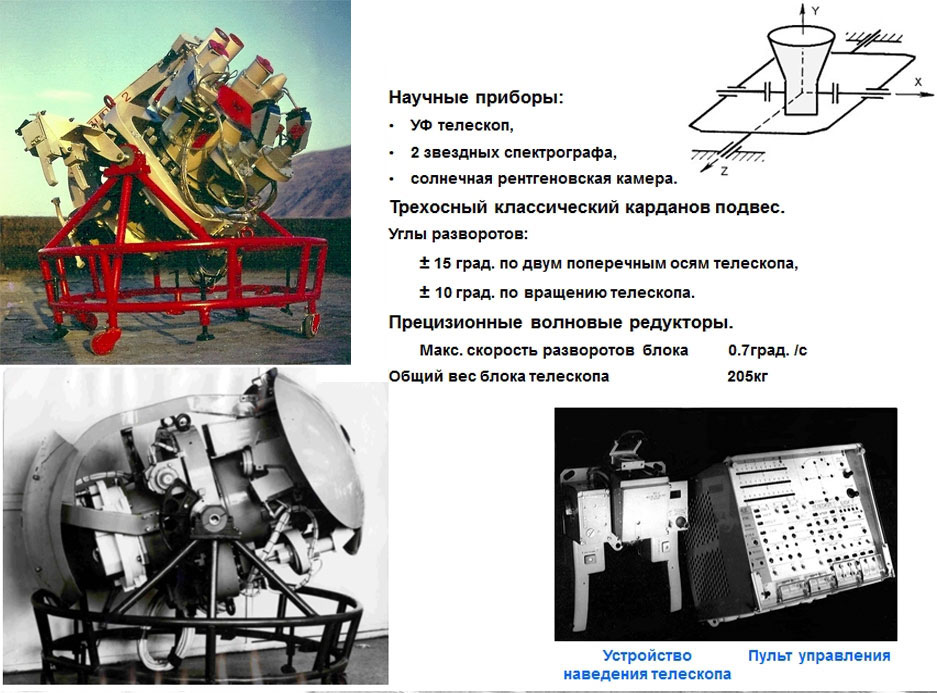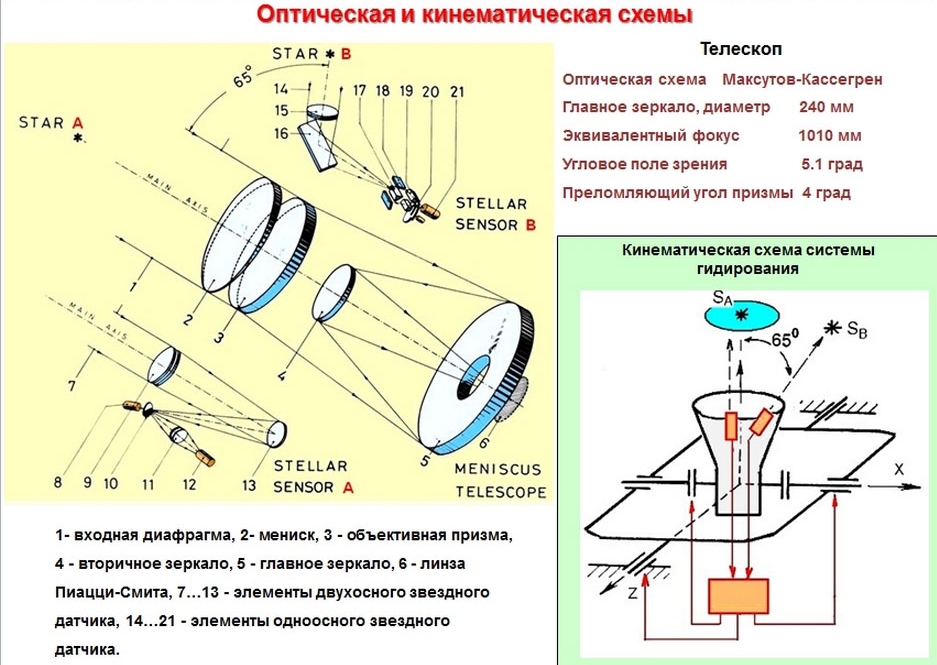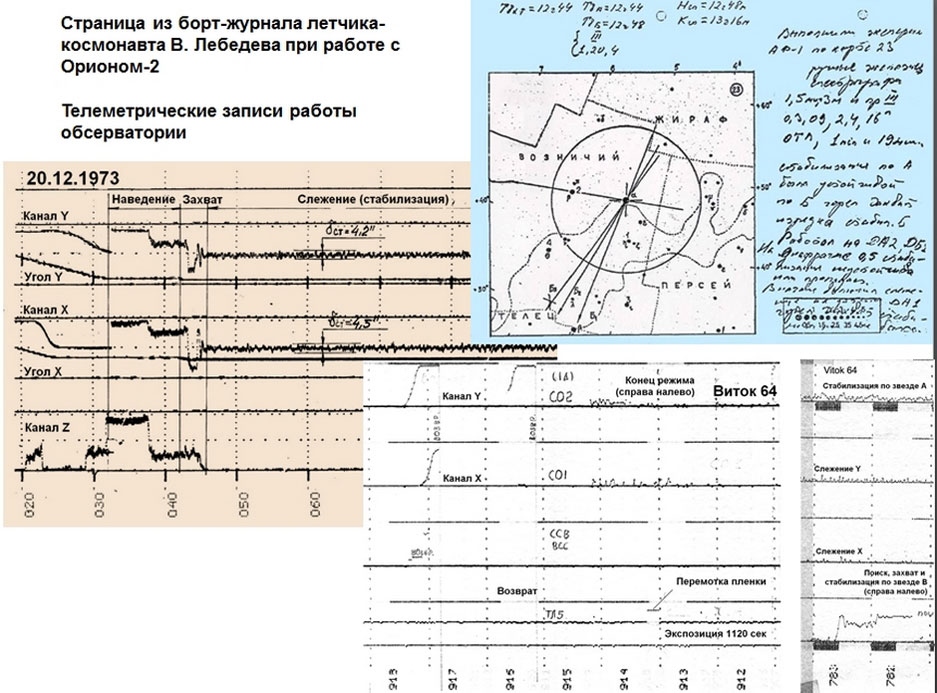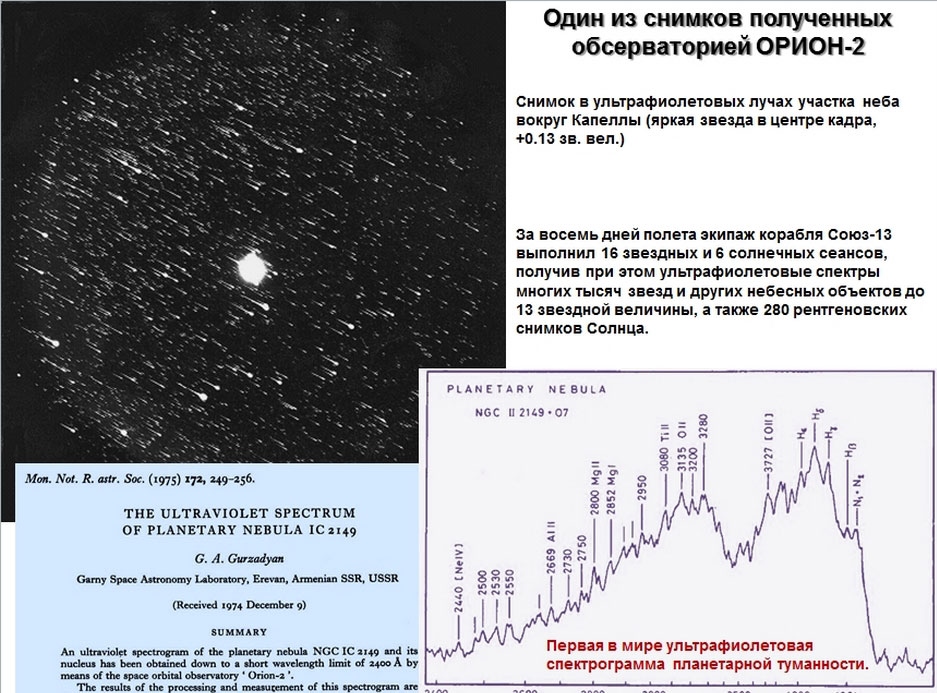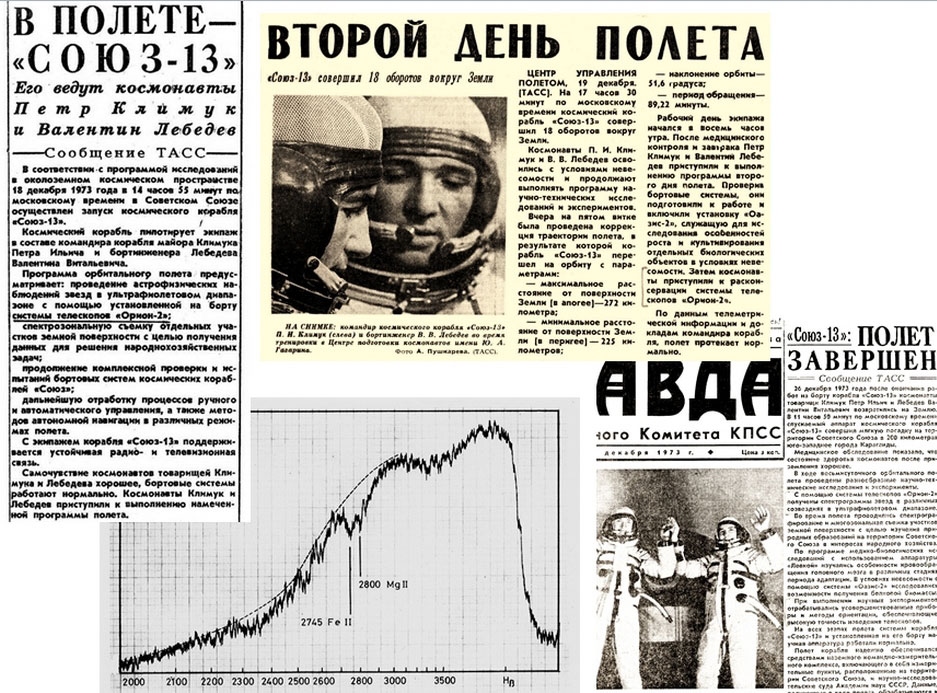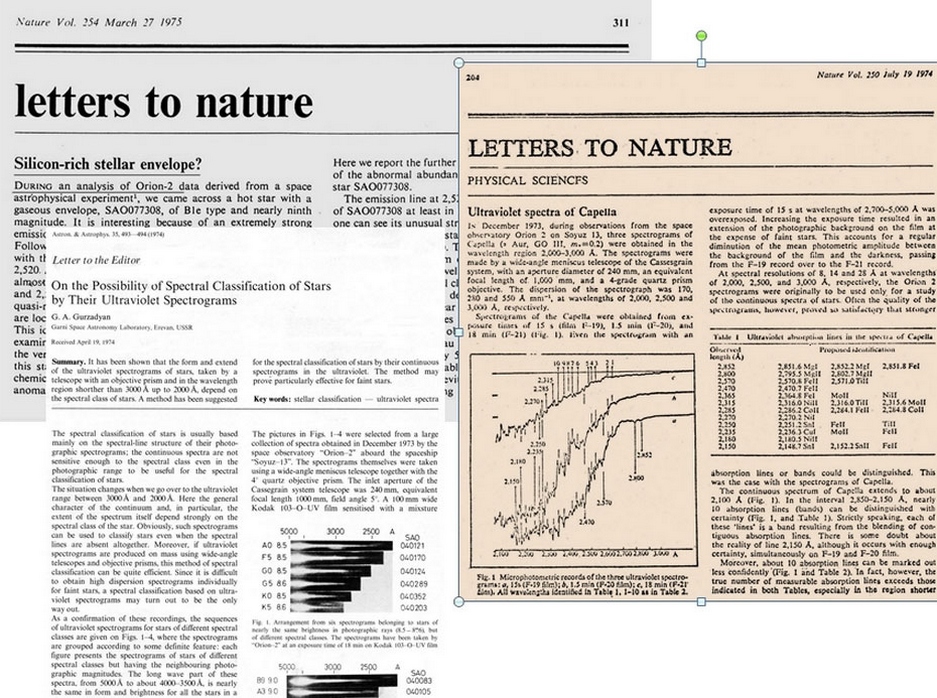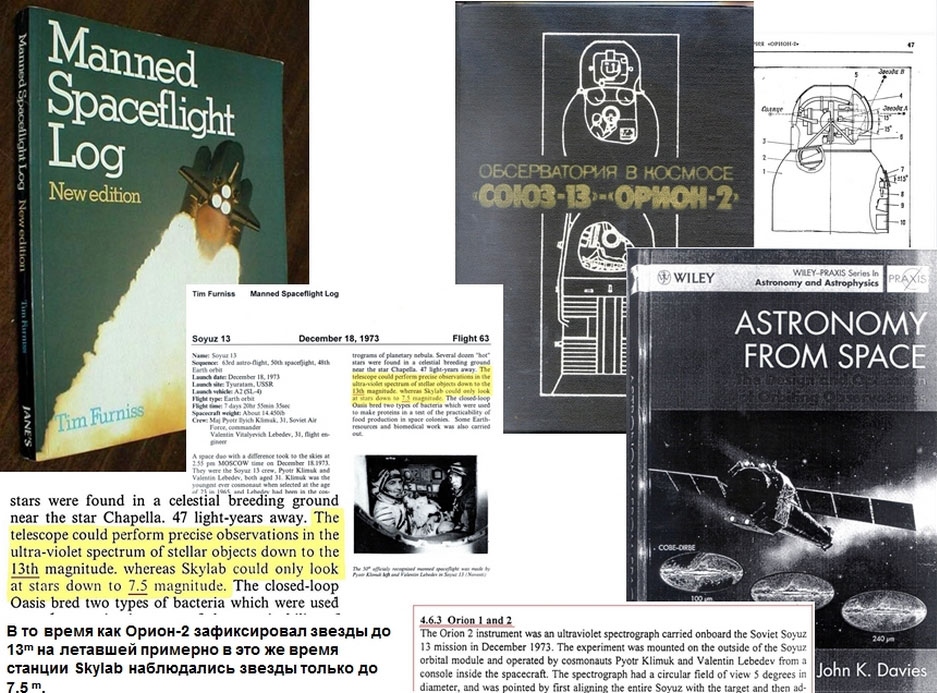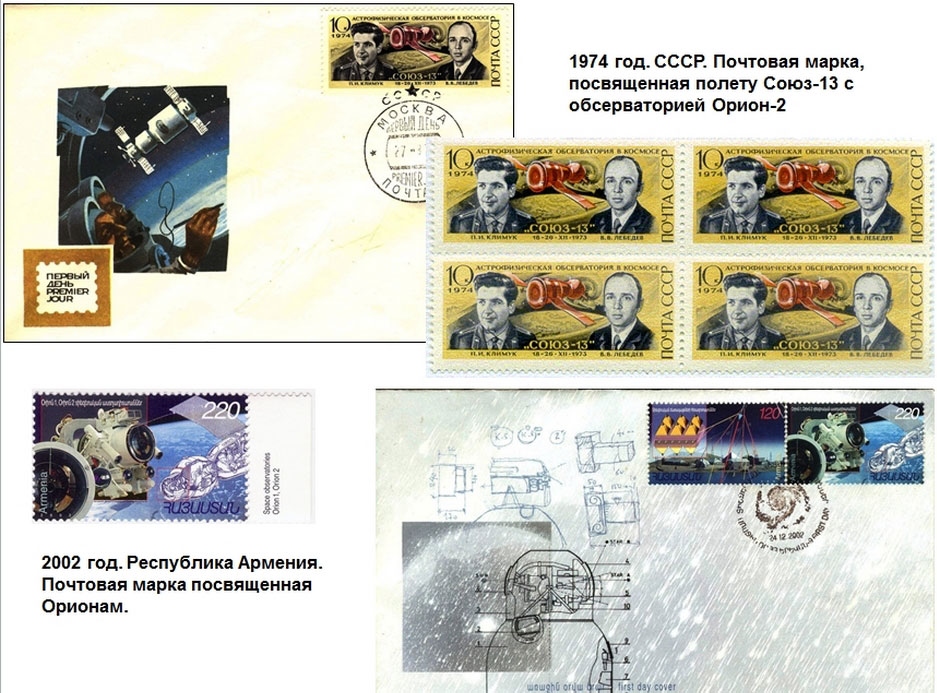(December 18-26, 1973)
Scientific supervisor – G. Gurzadyan
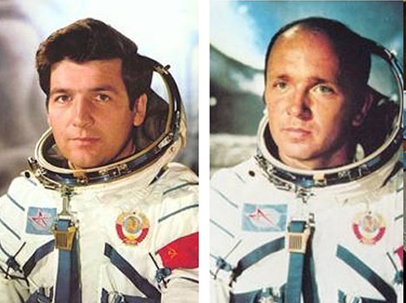
On December 18, 1973, the ORION-2 astrophysical observatory was launched into low-Earth orbit in the USSR. It was installed on the manned transport spacecraft SOYUZ-13, specially modified for this purpose.
Soyuz-13 – the first Soviet specialized manned spacecraft intended only for astrophysical research.
The main goal of the experiment is to obtain photographic ultraviolet spectrograms of areas of the starry sky in the wavelength range 2000 – 3000 Å.
The observatory included:
- UV telescope
- Sighting device
- Electronics unit
- Control panel
Spectrograms were recorded on special ultraviolet photographic film KODAK 103UV (frame diameter 90 mm). The cassette capacity was 20 m or 130 frames.
In addition to the telescope, the unit also included two stellar spectrographs installed coaxially with the telescope (devices G27 and G27A). A solar platform was located at the rear of the block. The G35 instrument for solar research and a solar guidance sensor were installed on it. The telescope unit also contained two sets of star guidance sensors (main and backup). Each set consisted of two types of sensors:
- two-coordinate, mounted coaxially with the telescope
- single-axis, the optical axis of which is located at an angle of 65° to the optical axis of the telescope.
The telescope was installed in a three-axis gimbal suspension (BT block), under a special protective dome.
The observatory was equipped with a three-axis guidance system based on two reference stars. The first of them (brighter than 3.5th magnitude) had to be in the center of the studied area of the sky, and the second (brighter than 3rd magnitude) – at an angle of approximately 65 degrees to it. The guidance accuracy along the transverse axes of the telescope was better than ±5 arc. sec., and relative to the optical axis – better than ±10 arc. sec.
Operation diagram of the Orion-2 observatory
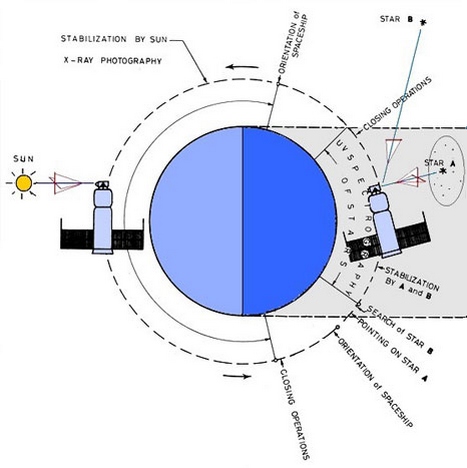 Star session (in the shadow part of the orbit):
Star session (in the shadow part of the orbit):
- Point the telescope at the first reference star A (in the center of the area under study).
- Capturing star A with a biaxial sensor and tracking this star along the two transverse axes of the telescope with an accuracy of ±5”.
- In star tracking mode A, the telescope is forced to rotate around the optical axis until the second reference star B enters the field of view of the single-axis sensor
- Capturing star B and tracking it relative to the optical axis of the telescope with an accuracy of ±10”.
- Execution of the exposure program.
- Turning off the observatory at the end of the exposure program (before leaving the shadow).
Solar session (on the solar part of the orbit):
- Upon command from the control panel, the solar sensor is turned on and automatic capture is carried out Sun and tracking with an accuracy of ± 10”.
- Execution of the exposure program.
- Turning off the observatory before entering the shadow area.
The main scientific results of Orion-2 were the following:
- For the first time, ULTRAVIOLET spectrograms of faint stars up to magnitude 13 were obtained.
- An energy decrease was discovered in the continuous spectra of hot stars within the 2000-3000 A band.
- ULTRAVIOLET observations of stars indicate the existence of circumstellar clouds of hot stars.
- An energy distribution of up to 2300 A for F, G, K type stars was established.
- Type A2 stars with an anomalous abundance of Mg were discovered.
- The first ULTRAVIOLET spectrogram of the planetary nebulae, IC 2149, was obtained. It showed
- existence of certain prohibited and permitted emission lines;
- two new chemical elements, aluminum and titanium were discovered in the planetary nebula
- lines 2669 Al II, 2800 Mg II were detected in the planetary nebula; 2852) which are important for the physics of these objects.
- The existence of two- photon emission of hydrogen in a planetary nebula.
- A rich silicon star has been discovered.
- Chromospheres of stars G, K up to M3 were discovered.
- It was shown that the 2800 Mg II spectral lines were the strongest lines for intermediate class stars.
- More than 300 spectrograms of Orion-2 made it possible to obtain empirical dependence of the equivalent width of 2800 mg II lines on spectral class. This relationship can have various applications in physics of stellar atmospheres
- A star classification method was proposed, based on UV spectrogram data
- A star-shaped object of unidentified nature with an ULTRAVIOLET excess was discovered.
- A group of hot, low-brightness stars was discovered near Capella, which later attracted the attention of many observation groups.
- A star cluster with interesting properties has been discovered in Auriga.
Publications:
- Gurzadyan, G.A., Ultraviolet spectra of Capella, Nature, vol. 250, p. 204, 1974.
- Gurzadyan, G.A., On the Possibility of Spectral Classification of Stars by their Ultraviolet Spectrograms, Astron. & Astrophys. vol. 35, p. 493, 1974.
- Gurzadyan, G.A., A Group of Ultraviolet Stars in Auriga, The Observatory, vol. 94,p. 293, 1974.
- Gurzadyan, G.A., An interesting ultraviolet star discovered by Orion-2, Astrophysics, vol. 10, p. 236, 1974.
- Gurzadyan, G.A., Kashin A.L., Krmoyan M.N., Oganesyan Dzh.B., Ultraviolet spectrograms of stars obtained on Orion-2, Astrophysics, vol. 10, no 2, pp. 109-112, 1974.
- Gurzadyan, G.A., Orion-2: First Scientific Results, Space Science Reviews, vol.18, p. 95-139, 1975.
- Gurzadyan, G.A., Rustambekova, S.S., Silicon-rich stellar envelope?, Nature, vol. 254, p. 311, 1975;
- Gurzadyan, G.A., Ultraviolet Chromospheric Lines in the Spectra of Late-Type Stars, Monthly Not. Royal Astron. Soc., vol. 172, p. 617, 1975.
- Gurzadyan, G.A., Ultraviolet Spectrophotometry of the Emission Star SAO 0400183, Astron. & Astrophys., vol. 39, p. 213, 1975.
- Gurzadyan, G.A., The Ultraviolet Spectrum of Planetary Nebula IC 2149, Monthly Not. Royal Astron. Soc., vol. 172, p. 249, 1975.
- Gurzadyan, G.A., Ultraviolet Continuous spectra of gamma Cassiopeia, Astron. & Astrophys., vol. 40, p. 447-450, 1975.
- Gurzadyan, G.A., Orion 2: first scientific results, Vestnik Akad. Nauk SSSR, no. 1, p. 13 – 24, 1975.
- Gurzadyan, G.A., Two-photon emission in planetary nebula IC 2149, Astronomical Society of the Pacific Publications, vol. 88, p. 891, 1976.
- Gurzadyan, G.A., Jarakyan, A.L., Krmoyan, M.N., Kashin, A.L., Loretsyan, G.M., Ohanesyan, J.B., Space astrophysical observatory Orion-2, Astrophysics and Space Science, vol. 40, p. 393, 1976.
- Gurzadyan, G.A., A high-power orbital telescope: What a telescope with a three-meter mirror carried into space can give to science, Vestnik Akad. Nauk SSSR, no.12, p. 80-90, 1977.
- Zaharyan, A.Z., Gasparyan, O.N., Stabilisation system of a orbital telescope of astrophysi¬cal observatory ORION-2, The collection of theses of reports of a seminar ‘The control systems, watching drives and their elements ‘, Moskow, 1977.
- Gurzadyan, G.A., Ultraviolet observations of planetary nebulae, Planetary nebulae. Observations and theory, Proc. IAU Symp.76, Ed.Y.Terzian, p.79, Dordrecht, D.Reidel Publ., 1978.
- Gurzadyan, G.A., Ultraviolet Spectra of Planetary Nebulae, Vistas in Astronomy, vol. 23, p. 45, 1979.
- Ambartsumian, V.A. (ed), Gurzadyan, G.A.; Raushenbach, B.V.; Feoktistov, K.P.; Klimuk, P.I.; Lebedev, V.V.; Maksimenko, A.P.; Gorshkov, K.A.; Savchenko, S.A.; Baryshnikov, G.K.; Pachomov, A.I.; Antonov, V.V.; Kashin, A.L.; Loretsian, G.M.; Gasparyan, O.N.; Chabrov, G.I.; Ohanesian, J.B.; Tsybin, S.P.; Rustambekova, S.S.; Epremian, R.A. Observatory in space “SOYUZ-13”-“ORION-2” . “Mashinostroenie” Publ., Moscow, 1984 (monograph, in Russian).
- Gurzadyan, G.A., Ohanesyan, J.B., Rustambekova, S.S., Epremian, R.A., Catalogue of 900 Faint Star Ultraviolet Spectra, Publ. Armenian Acad. Sci., Yerevan, 1985.
- Oberg J., Notes on Soviet space astronomy, Sky & Telescope, vol. 53, 92, 1977.
- Abt, H.A., Spectral types in Gurzadyan’s clustering in Auriga, Astronomical Society of the Pacific Publications, vol. 90, p. 555, 1978.
- Furniss, T., Manned Spaceflight Log, Jane’s, London, 1986.
- Davies, J. K., Astronomy from Space, PRAXIS Publishing, Chichester, 2002.
Last Updated on 2025.01.09
